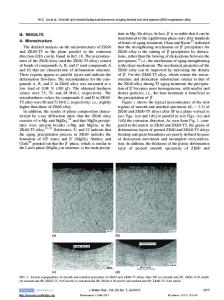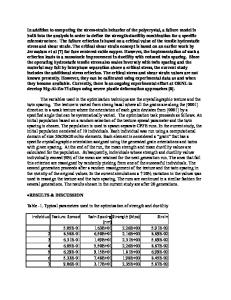Extraordinary superplastic ductility of magnesium alloy ZK60
- PDF / 801,409 Bytes
- 4 Pages / 612 x 792 pts (letter) Page_size
- 0 Downloads / 393 Views
Extraordinary superplastic ductility of magnesium alloy ZK60 R. Lapovok,a) R. Cottam, and P.F. Thomson School of Physics and Materials Engineering, Monash University, Victoria 3800, Australia
Y. Estrin Institut für Werkstoffkunde und Werkstofftechnik, TU Clausthal, 38678 Clausthal-Zellerfeld, Germany (Received 3 December 2004; accepted 9 March 2005)
Exceptionally high tensile ductility of commercial Mg alloy ZK60 is reported. It was achieved by equal channel angular pressing without any extra processing steps. The tensile ductility at 220 °C was 2040% and 1400% for the strain rates of 3 × 10−4 s−1 and 3 × 10−3 s−1, respectively. The strain rate sensitivity of the flow stress exhibited a value slightly above 0.5, which is characteristic of superplastic deformation. The grain structure associated with this behavior was shown to be bi-modal with further separation in two fractions with different grain sizes within the small grain size population.
For a long time, the question of whether superplastic properties can be achieved in magnesium alloys, which normally have limited ductility due to their hexagonal close-packed (hcp) crystal structure, has been challenging materials scientists and technologists. However, even for widely investigated Mg alloys such as ZK60 (Mg– 5.8% Zn–0.6% Zr),1–8 there is no consensus about the optimum thermomechanical processing route leading to enhanced tensile ductility. Of special interest to the manufacturing industry is the superplastic behavior of ZK60 in the low-temperature range (below 280 °C) at acceptable strain rates from 3 × 10−3 s−1 upward. Summarizing published results,1–8 it can be noted that severe plastic deformation methods, which have been used to refine the grain structure, resulted in either uniform fine-grained2–7 or bimodal microstructures.1,2,8 The latter are characterized by coexistence of two populations of grains with distinctly different average size and morphology. Generally, superplastic behavior was attributed to uniform distributions of small grains, the tensile ductility being improved by decreasing average grain size. The maximum elongation achieved in ZK60 processed by equal channel angular pressing (ECAP) resulting in uniform grains of 1 m in diameter was 800%.7
a)
Address all correspondence to this author. e-mail: [email protected] DOI: 10.1557/JMR.2005.0180 J. Mater. Res., Vol. 20, No. 6, Jun 2005
A very high tensile ductility with an elongation of 1200% was obtained in bimodal microstructures1 produced by double extrusion with large reductions in cross-section. Surprisingly, the use of ECAP for grain refinement, which produced similar bimodal microstructures, did not yield such a good tensile ductility.2,8 The ability of ECAP to refine microstructure and create a favorable texture to the same extent extrusion does, was questioned, and a two-step processing route—namely, extrusion followed by ECAP—was proposed9 to improve superplastic characteristics of magnesium alloys. The questions of whether a superplastic elongation beyond the
Data Loading...











